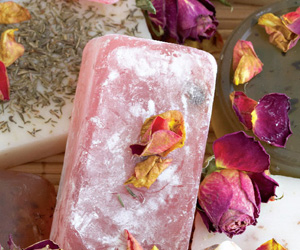
What is soap?
Soap is made by mixing an alkaline substance, usually caustic soda (sodium hydroxide), with plant or animal fat. The caustic soda is first mixed with a liquid to form a caustic solution or lye.
It is then added to heated oils, at which point a process known as saponification takes place. The solution is stirred and it starts to thicken until it reaches the trace stage.
Basic ingredients
Most types of soap are made with a few basic ingredients. The ratio of the different ingredients can be adjusted to make the soap foam more, or give it a coarser texture, for example.
Cow's milk or goat's milk is sometimes used to aid the chemical process, and although these ingredients usually give the soap a wonderfully creamy texture, their inclusion is best left to the experts.
Types of soap
Different oils are heated over a low heat, then essential oils are added and the mixture is poured into moulds. It cools in the moulds and is then refrigerated to harden completely.
Caustic soda is dissolved in water and the oils are heated over a very low heat. The caustic-soda solution or lye is then stirred into the oils until the mixture reaches the trace stage.
The mixture is poured into a container and has to stand for 24 to 48 hours to cool and set. The soap is then removed from the container, but has to be stored for another six to eight weeks before it is ready to use.
Fragrance
Essential oils are the quickest and easiest way to add fragrance to soap. Choose an essential oil that will complement the type of soap you are making, and the purpose for which it will be used.
Find out about the properties of a specific essential oil before experimenting with it. Essential oils can be costly, and can easily ruin your soap if they are not used correctly.
Colour
The organic matter that is used in the soap-making process will lend its natural hues to the finished product.
However, these colours are often muted, so there are a few ways in which you can up the intensity. Clear soap can be coloured with food colouring.
Massage or moisturising melts and cold-processed soap can only be coloured with natural pigments such as cayenne pepper, turmeric, curry powder or cinnamon. Always bear in mind that natural pigments may react with the other ingredients, causing the colour to change or become dull.
Most craft shops stock liquid colorants that are used specifically for colouring soap, or you can use wax chips. Some manufacturers even use broken wax crayons to colour their soap. Take care not to overdo the colour – it could easily give off pigment that might stain your towels.
Warning
Caustic soda should be handled with care – it is very strong and can cause serious burns if it comes into direct contact with your skin.
Always keep it out of reach of children and wear a pair of protective gloves and an apron when you work with it. It is also advisable to wear a mask that covers your nose and mouth, as the lye emits strong fumes.
Protect your eyes with a pair of safety glasses (you can even wear a pair of swimming goggles). Always keep lemon juice or vinegar nearby when working with caustic soda.
Splash some onto the affected area immediately if the caustic-soda solution comes into contact with your skin, then rinse well with water.
Tools
You will have most of these items in your kitchen, but bear in mind that you won't be able to use them for preparing food again.
Use stainless-steel or plastic items that will be able to withstand the heat that is released during the chemical process. Wood and aluminium are not suitable, because they could react with the chemicals. This is a general list of items that you'll need:




 Publications
Publications
 Partners
Partners












